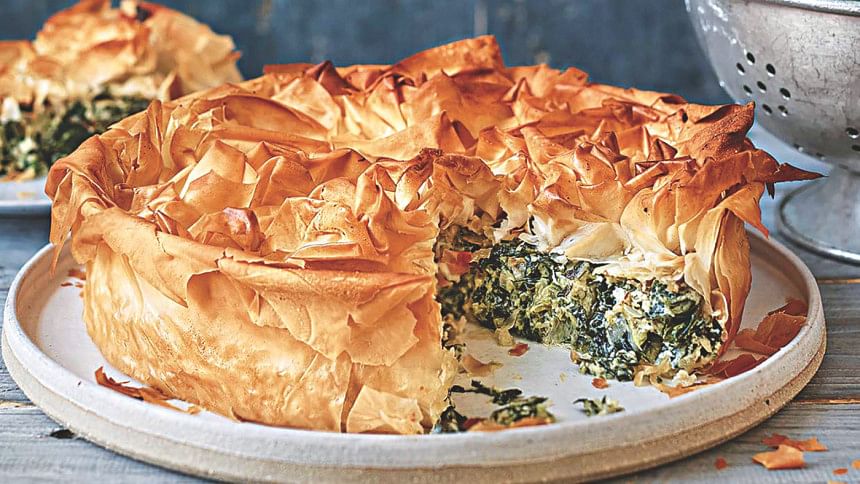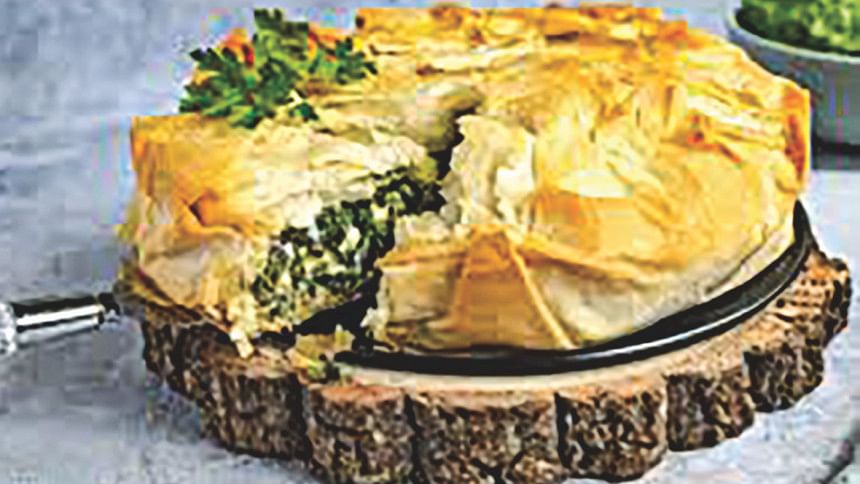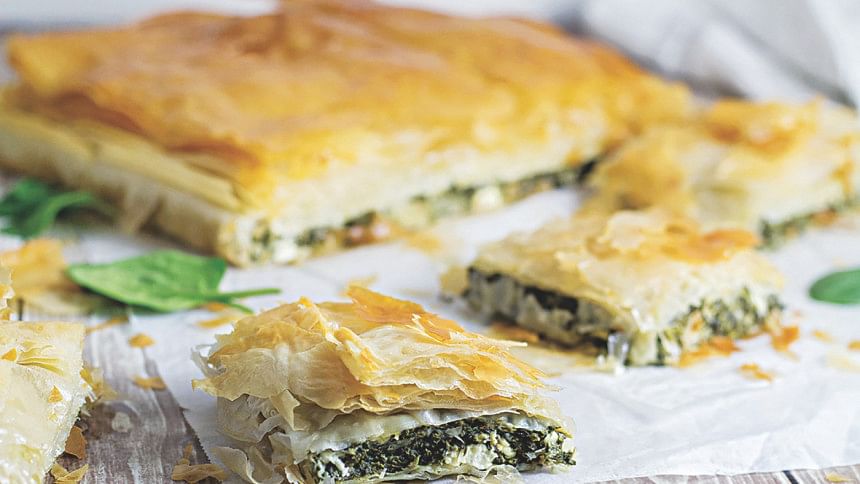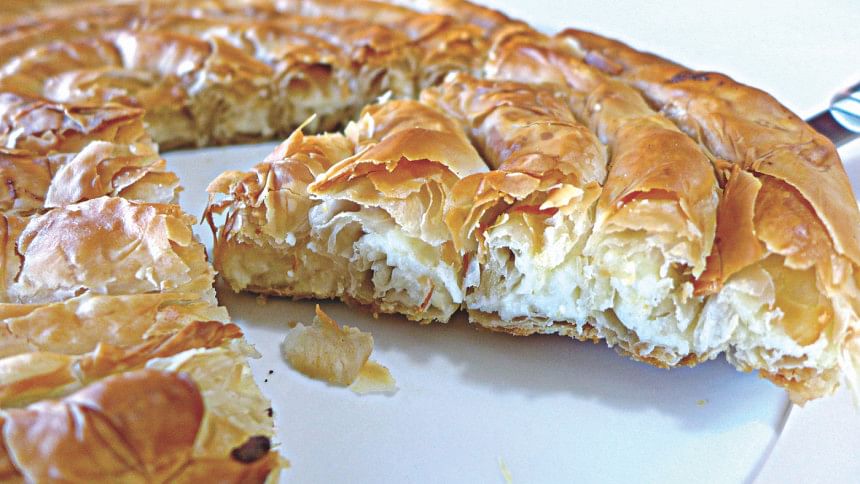Treasured desserts

October is here, and we can finally enjoy the slightly cooler weather, which will hopefully roll into a winter that lets us all enjoy our hot soups and steaming mugs of tea. With that in mind, here are a few recipes to encourage you to get more creative in the kitchen this week.
PORTOKALOPITA: ORANGE PIE
Pies and Greek food are synonymous, as anyone visiting this country seeped in history will realise. 'Pita' stands for a single pie while 'pitarakia' means a small pie, perhaps a mouthful even. This recipe combines some of Greece's best-known treasures of fresh oranges (portokali) and Greek yoghurt to make a pie with layers of flavours.
Ingredients
For the syrup —
400g caster sugar, or normal sugar
350ml water
1 orange, juiced
1 tsp ground cinnamon
For the cake —
450-500g phyllo pastry
3 oranges, 4-5 eggs
200g Greek yoghurt (you can use hung yoghurt instead)
180ml olive oil (you may use sunflower oil if you want)
100g granulated sugar
1 tbsp baking powder
Method
Combine all syrup ingredients in a small saucepan and bring to boil, simmering it for about 4 minutes. Remove from heat and allow to cool whilst you make the cake.
Preheat oven to 180° C.
Lightly grease a baking dish with olive oil. Take each sheet of phyllo and using your hands, start tearing it and shred it in bite sized chunks, and sprinkle all over the baking dish to make a base.
Zest about two oranges and juice one. Combine the juice, zest, eggs, yoghurt, olive oil, 100g sugar and baking powder in a bowl, in a blender or food processor. Now, blend together on high speed for a couple of minutes, until the mixture is frothy.
Pour the orange and the egg mixture over the phyllo in the baking tin. Stir together gently, right in the tin, to ensure the egg mixture is evenly distributed. Bake for 45 minutes, or until the top is golden and the filling inside seems set.
Once out of the oven, immediately pour the cooled syrup over the hot cake. Set aside for at least 1 hour, until most of the syrup has soaked in.
Serving
Cut it into tiny squares and you can serve it with some ice cream also.

GREEK FILO WRAPS: HERB INFUSED
The word 'filo' comes from the Greek word of 'fila' or leaf, and like leaves, these thin layers of dough envelop themselves around anything to give us some of the best foods. Baklava is a great example, but although filo could have gained a more conventional or solid identity during the Byzantine era, the ancient Greeks are known to have liked eating food wrapped in layers of dough.
Homer mentioned it in the Odyssey and filo today is eaten in a number of countries like Turkey, Bulgaria, etc. with their own renditions.
Ingredients
250g minced beef (you may use chicken)
1 tbsp apple cider vinegar
2 tbsp diced leeks, or onions
150-200g Dhaka paneer, or feta cheese
1 tbsp diced olives
3-4 tbsp olive oil
1 packet of filo pastries (you can also make them yourself)
Pinch of salt, pepper, nutmeg, and cumin powder
300g combined diced carrots, grated zucchini or diced pumpkin, corn, onions, or spring onions
1 tbsp grated garlic
½ tsp diced celery
Add dill, or basil to change the flavours.

Method
Sauté the minced meat with some leeks and diced garlic in olive oil until it changes colour (about 3-4 minutes). Add some salt, pepper, apple cider vinegar, and nutmeg. Remove from heat and blanch the carrots and the corn for about 1 minute.
Mix the meat with all the vegetables, herbs and olives, with the cheese. You can keep this meatless and just make it a vegetarian dish. Wrap the food in a filo and roll it out along its length and fold at ends. This should resemble a tiny log.
On top of this mini log, place a long strand of coriander, mint, basil, rosemary, or any herb you would like to place, which looks pretty through the layers. Wrap an extra layer of filo and make sure the strand of herb remains intact and is visible. You might need to layer it twice.
Brush extra olive oil on this (you can cheat a bit and smear some ghee on it, as long as you do not overdo it!) pre-heat the oven for 10 mins at 180° C then place the long on a well-oiled tray. Cook them for about 15 minutes and you can keep checking. The filo packets turn golden brown when ready.
Serving
Serve it with a Greek yoghurt mixed with basil and chilli flakes, and a little olive oil, or roasted tomatoes, blended with cumin, and salt and pepper.

WATALAPPAN
The Dutch have contributed to the cuisine of this region in more ways than we know, and the watalappan — a sweet, jaggery cake from Sri Lanka also credits its origins to these foreign invaders.This dish was originally called Vla, Dutch for custard. The Muslim community in Sri Lanka mainly prepares this now, but it is gleefully consumed by everyone. It has now adopted the more Tamil term of 'vattil-appan,' loosely translating to cupcake.
Ingredients
200ml coconut milk
2 eggs
100g jaggery
2 tbsp brown sugar
1 tbsp roasted cashew nuts, cracked into large pieces
Pinch of nutmeg powder and cardamom pods
Method
Grate the jaggery and whisk the eggs into a semi fluffy state, because you want the mixture to be rather clunky and not super smooth. Add brown sugar, jaggery, cardamom, coconut milk, nutmeg powder and blend some more, but just before it reaches a fluffy stage. You can steam this cake, if you want. Place it in a steamer bowl and steam for about 15 minutes. Take it out to check, then put it back in to cook a bit. The watalappan needs to set. If you bake it, take no more than 25-30 minutes. The cake turns out soft and pudding like.
Serving
Serve it cold with the cashews sprinkled on top.
Photo: Collected

 For all latest news, follow The Daily Star's Google News channel.
For all latest news, follow The Daily Star's Google News channel. 



Comments